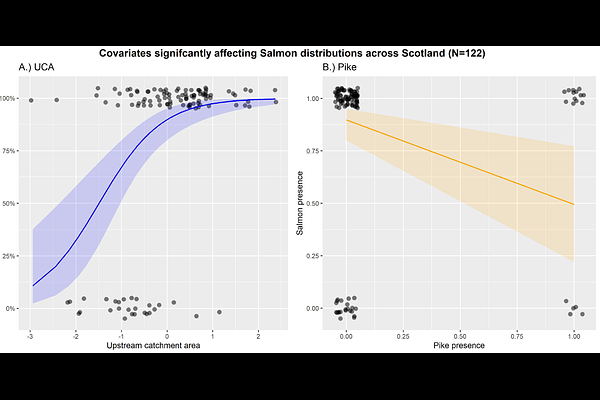eDNA sampling reveals no negative effects of beaver recolonisation on the catchment-scale distribution of migratory fish

eDNA sampling reveals no negative effects of beaver recolonisation on the catchment-scale distribution of migratory fish
Macarthur, J. A.; Law, A.; Willby, N.; Svobodova, D.; Griffiths, N. P.; Campbell, R.; Gaywood, M. J.; Bean, C. W.; Lawson Handley, L.; Smith, M.; Leonard, S.; Conroy, C.; Pritchard, V. L.; Hänfling, B.
Abstract1. Reintroduction of keystone species is considered part of the solution to the current biodiversity crisis. The Eurasian beaver (Castor fiber) is one such species, shaping its habitat by felling trees, building dams and creating wetlands. However, while the potential benefits to aquatic biodiversity and ecological functioning have been studied on a local scale, the impacts of beavers on catchment-scale processes such as fish migration remain understudied. 2. Sequencing of environmental DNA (eDNA metabarcoding) from water samples is a cost-effective method to study species distributions across large geographical scales. Here, eDNA samples (n=426) were collected from 142 sites across the UKs oldest and largest established wild beaver population, located on Tayside, East Scotland, and analysed using a vertebrate specific metabarcoding assay. We combined presence/absence data from eDNA results with other environmental and anthropogenic variables to model the effects of beaver presence on the distribution of three migratory fish species. 3. Using generalised linear models, we found no effects of the current beaver presence on the distribution of Atlantic salmon or lamprey, but a positive co-occurrence with European eel at the catchment scale. Model outputs also reinforced previous findings on the impact of barriers to migration and other abiotic and biotic factors on fish species, demonstrating the effectiveness of eDNA sampling in rivers for understanding species distributions at a catchment scale. 4. This case study provides novel insights into the co-distribution of beavers and migratory fish, and highlights how catchment-wide eDNA monitoring can be applied by environmental managers to aid decision-making and impact assessment more generally.